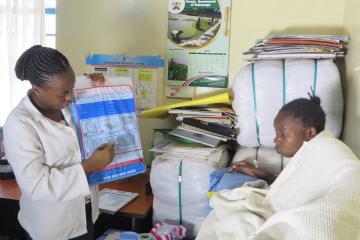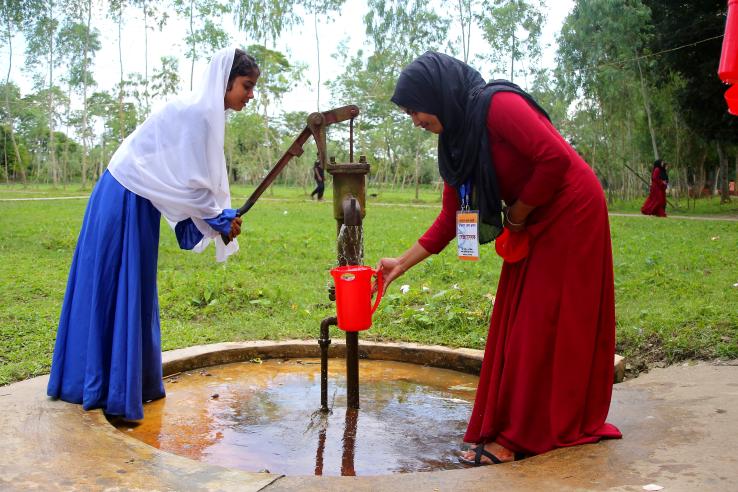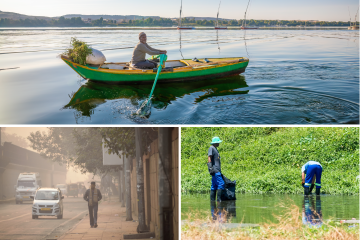
Pairing insights from engineering, public health, and behavioral science to improve access to and use of clean water

Summary
As of 2020, approximately two billion people, or 26 percent of the world’s population, did not have access to safely managed drinking water.1 One of the United Nations Sustainable Development Goals focuses on improving the availability and sustainability of safe drinking water and sanitation for all by 2030. The world is not on track to meet this target.2 Furthermore, water stressors will likely increase with climate change, impacting many communities' access to uncontaminated water that is free of bacteria, viruses, or other pathogens.3 Climate change intensifies water scarcity as water supplies are negatively impacted, while water pollution and extreme weather events can contaminate water sources.3
Many individuals in high-income countries rely on methods of disinfection like in-line chlorination4 or centralized treatment of piped water.5 Estimates suggest that over two billion people in low- and middle-income countries could benefit from passive in-line chlorination.5 But some water sources remain unsuitable for in-line chlorination, especially in rural areas of sub-Saharan Africa, because they are not compatible with passive chlorinators (e.g., the water is manually extracted, such as from unprotected springs or manually dug wells; is turbid or cloudy; supply is intermittent; or flow rate is low).5 6 Prior environmental engineering and public health research on improving water safety has yielded various point-of-collection (POC) options7, such as spring protection and making chlorine available via dispensers, as well as point-of-use (POU) interventions8 like home chlorine treatment and water filtration. A review of eight randomized evaluations from six low- and middle-income countries identifies key interventions to promote the adoption of POC and POU strategies.
Supporting evidence
Providing uncontaminated water at the source (or point-of-collection) that remains uncontaminated during storage is optimal. However, access to such water can be challenging, especially in areas where households are far from one another. Many people living in poverty around the world get their water from springs, streams, or wells and rely on proven technologies to reduce the amount of contamination from groundwater before using the water.
Spring protection, which involves encasing springs in concrete to force water to flow through a pipe and prevent contamination from groundwater, can help improve water quality relative to only using unimproved water sources. However, water can become recontaminated during transport and storage. In Western Kenya, a local NGO, with labor inputs from local communities, encased a randomly chosen set of springs in concrete. This reduced E. coli contamination of water at the source by 66 percent. Child health outcomes improved as a result—self-reported diarrheal incidence among children under three years old decreased by 4.7 percentage points (a 25 percent decrease). Spring protection averted approximately 300 diarrheal incidents per US$1000 spent. However, the improvement in the quality of household drinking water that had been stored was smaller, at 24 percent[5]. This indicated that water was recontaminated during transport or storage, thereby preventing the health gains from being maximized. Similarly, boreholes, storage tanks, and piped water supplies are other approaches that can improve water quality but risk this type of recontamination. The World Health Organization (WHO) recommends treating water with chlorine.9
Spring protection is particularly relevant in contexts where households do not need to travel far to access the springs. In less-dense areas with only a few households per water source, free individual supply of water treatment is an alternative to provide access to uncontaminated water.
Providing POC and POU water treatment devices and products for free increases take-up and use. Protecting a water source does not necessarily lead to uncontaminated drinking water at the household level. To ensure safe household drinking water, the WHO recommends treating water with chlorine solution9. Across three studies[4][3][8] testing the impact of full subsidies for chlorine through home delivery or vouchers for free chlorine[4][3] or provision of point-of-collection chlorine dispensers[8] in Kenya and Malawi, all found that such interventions increased the share of households drinking chlorinated water. Specifically, full subsidies for chlorine raised the percent of households with detectable chlorine in their drinking water in the year following program inception to 34 percent (compared to 12 percent in a partial subsidy group) in Kenya[4], and to 30.3 percent in Malawi (from a base of 3.8 percent in a pure comparison group)[3].
In a separate study in Kenya[8], chlorine dispensers installed by the water source (i.e., at the point of collection) increased the share of households with detectable chlorine in their drinking water to 39 percent (compared to 3 percent in the comparison group) in the first year of the program. In the second year, chlorine usage among the intervention group was 23 percent, versus 3 percent in the comparison group. The drop in usage rate from year one to year two among the intervention group may have been due to a decrease in community promoters’ engagement and activities, as chlorine dispensers were supposed to be maintained and refilled by unpaid community promoters.
While the studies cited above show that free access to chlorine at point-of-use or point-of-collection substantially increased coverage of uncontaminated water, they also show that a majority of households do not use chlorine regularly even when it is free. This could be because POU treatments place the burden on households to exert continued effort.10 Water treatment solutions must be used on a regular basis, sometimes daily, a level of consistency which individuals may find difficult to achieve[3].
Could more households be encouraged to use free water treatment products? In Malawi[3], community health workers (CHWs) were assigned different chlorine delivery methods to determine the impact on chlorine usage and health outcomes. A subset of CHWs incorporated education on how to best promote safe drinking water and chlorine usage during their household visits while other CHWs also provided free chlorine directly to households on a monthly basis. The health promotion by CHWs in either form did not increase chlorine usage above the 30 percent rate observed among households who received vouchers for free chlorine with no CHW engagement.
Combining subsidies with nudges can increase usage rates somewhat, especially for unfamiliar products. One study of two parallel programs, one in rural Kenya and one in urban slums in Bangladesh, showed that providing nudges alongside free or subsidized products can motivate use in the short run[7]. Households in these contexts received one of three free POU products, alongside information about the health benefits of using water treatment products. The health benefits information was framed either positively (“gains” from using the more traditional marketing message) or with a “contrast frame”—contrasting what one stands to lose from non-use with the gains from use. A random subset of households also verbally committed to using one of the three free POU products and was provided with a poster to remind them of their commitment. Immediate take-up was very different across the two contexts: usage of the freely provided products was as high as 50 percent in rural Kenya, but as low as 13 percent in urban Bangladesh. The combined “contrast frame” and commitment-with-reminder intervention increased observed usage rates by 4 percentage points in Bangladesh and 7 percentage points in Kenya, compared to households who received the free products and the traditional message.
The durability of POU products is an important determinant of long-run impacts. When packets of chlorine were distributed for free door-to-door in Pakistan[6], alongside information provision, regular monitoring by CHWs, and storage containers designed to reduce water contamination, the program decreased bacterial contamination by 99.8 percent (compared to an 8 percent reduction in the comparison group) and prevented 115 diarrheal incidents per $1,000 spent. However, 28 percent of the improved storage containers provided to households broke after two years. Meanwhile, on average, families whose containers did not break continued to use them for decontamination and storage two years after the program’s inception. This suggests that ensuring an affordable water treatment product is also durable can bolster long-term usage. In Ghana[2], where water filters were provided for purchase, the expected lifetime of the product was two years if well-maintained through regular cleaning. In this context, 50 to 60 percent of filters were damaged after one year, highlighting the importance of product durability.
Targeting subsidies for POU products to households most likely to use them reduces wastage and further increases their cost-effectiveness. Not all households are interested in using chlorine to treat their water at home. Some do not use it because they have access to a safe water source or because they do not like the taste of chlorinated water. This has implications for the relative cost-effectiveness of various mechanisms to deliver fully subsidized chlorine. In particular, systematic delivery of free chlorine to households generates more “unused” chlorine than asking interested households to pick up the subsidized chlorine from a central location. Four studies from Kenya, Malawi, Ghana, and Zambia[4][3][2][1] suggest households who are more willing to exert effort or spend resources to acquire POU products are more likely to use them.
Studies in Ghana and Zambia elicited how much households were willing to pay for POU products before offering them subsidies. In Ghana[2], household usage of a water filter was initially independent of the price paid, though only those who had been willing to pay a higher price for the water filter continued using it in the longer term. Likewise, in Zambia[1], households were offered an inexpensive chlorine bleach solution for a randomly determined and varying below-market price, and those who chose to buy the product were then offered it at a discount. As the price increased from US$0.09 to US$0.25, one-time purchase of the chlorine solution dropped from 76 percent to 44 percent, resulting in lower overall coverage under the higher price than the lower price. Among the smaller set of households who agreed to purchase the solution at the higher price, usage rose from 41 percent to 60 percent. However, according to calculations based on information in the study, overall use of chlorine decreased with higher prices due to diminished demand.
Studies in Kenya and Malawi focused on non-financial targeting to avoid potentially excluding households that would use the POU products but simply could not afford them. In Kenya[4], researchers compared two different approaches to fully subsidizing chlorine—providing a large bottle of chlorine sufficient to cover households for 3.5 to 5.5 months (depending on household size), hand-delivered at baseline and renewed once through home delivery, versus distributing twelve vouchers that households could redeem once per month for a smaller bottle of chlorine treatment. Variants on these two designs were also tested in Malawi[3] over an eighteen-month period. In both contexts[3][4], asking households to actively seek out the free chlorine screened out almost all households who would have accepted but not used the free product distributed by health professionals while excluding few households who would have used the product but were unwilling or unable to redeem the voucher. In Malawi[3], coupons were nearly twice as cost-effective at increasing chlorine usage than home delivery and cost US$2.62 to avert one child illness, compared to US$10.62 for home delivery. These studies suggest that non-financial targeting can effectively identify which households would be most likely to continue using a product in the longer term without eliminating those unable to pay a higher price.
Abdul Latif Jameel Poverty Action Lab (J-PAL). 2024. "Pairing insights from engineering, public health, and behavioral science to improve access to and use of clean water." J-PAL Policy Insights. Last modified June 2024.
UN-Water. 2021. “Summary Progress Update 2021 – SDG 6 – water and sanitation for all.” Geneva, Switzerland. Accessed December 22, 2023. https://www.unwater.org/publications/summary-progress-update-2021-sdg-6-water-and-sanitation-all.
Ashraf, Nava, James Berry, and Jesse M. Shapiro. 2010. "Can higher prices stimulate product use? Evidence from a field experiment in Zambia." American Economic Review 100(5): 2383-2413. Research Paper | Evaluation Summary
Berry, James, Greg Fischer, and Raymond Guiteras. 2020. "Eliciting and utilizing willingness to pay: Evidence from field trials in Northern Ghana." Journal of Political Economy 128 (4): 1436-1473. Research Paper | Evaluation Summary
Dupas, Pascaline, Basimenye Nhlema, Zachary Wagner, Aaron Wolf, and Emily Wroe. 2023. "Expanding access to clean water for the rural poor: experimental evidence from Malawi." American Economic Journal: Economic Policy 15(1): 272-305. Research Paper | Evaluation Summary
Dupas, Pascaline, Vivian Hoffmann, Michael Kremer, and Alix Peterson Zwane. 2016. "Targeting health subsidies through a nonprice mechanism: A randomized controlled trial in Kenya." Science 353 (6302): 889-895. Research Paper | Evaluation Summary
Kremer, Michael, Jessica Leino, Edward Miguel, and Alix Peterson Zwane. 2011. "Spring cleaning: Rural water impacts, valuation, and property rights institutions." The Quarterly Journal of Economics 126 (1): 145-205. Research Paper | Evaluation Summary
Luby, Stephen, Mubina Agboatwalla, Abida Raza, Jeremy Sobel, Eric Mintz, Kathleen Baier, Mohammad Rahbar et al. 2001. "A low-cost intervention for cleaner drinking water in Karachi, Pakistan." International Journal of Infectious Diseases 5 (3) : 144-150. Research Paper
Luoto, Jill, David Levine, Jeff Albert, and Stephen Luby. 2014. "Nudging to use: Achieving safe water behaviors in Kenya and Bangladesh." Journal of Development Economics 110 (Sept): 13-21. Research Paper
Null, Clair, Christine P. Stewart, Amy J. Pickering, Holly N. Dentz, Benjamin F. Arnold, Charles D. Arnold, Jade Benjamin-Chung et al. "Effects of water quality, sanitation, handwashing, and nutritional interventions on diarrhoea and child growth in rural Kenya: a cluster-randomised controlled trial." The Lancet Global Health 6 (3): e316-e329. Research Paper
